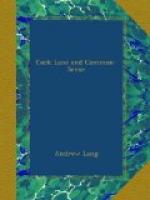In a paper in the Proceedings of the Society for Psychical Research (part xiv.), an anonymous writer gives the results of some historical investigation into the antiquities of crystal-gazing. The stories of cups, ‘wherein my lord divines,’ like Joseph, need not necessarily indicate gazing into the deeps of the cup. There were other modes of using cups and drops of wine, not connected with visions. At Patrae, in Greece, Pausanias describes the dropping of a mirror on to the surface of a well, the burning of incense, and the vision of the patient who consults the oracle in the deeps of the mirror. {216a} A Christian Father asserts that, in some cases, a basin with a glass bottom was used, through which the gazer saw persons concealed in a room below, and took them for real visions. {216b} In mirror-magic (catoptromancy), the child seer’s eyes were bandaged, and he saw with the top of his head! The Specularii continued the tradition through the Middle Ages, and, in the sixteenth century Dr. Dee ruined himself by his infatuation for ‘show-stones,’ in which Kelly saw, or pretended to see, visions which Dr. Dee interpreted. Dee kept voluminous diaries of his experiments, part of which is published in a folio by Meric Casaubon. The work is flighty, indeed crazy; Dee thought that the hallucinations were spirits, and believed that his ‘show-stones’ were occasionally spirited away by the demons. Kelly pretended to hear noises in the stones, and to receive messages.
In our own time, while many can see pictures, few know what the pictures represent. Some explain them by interpreting the accompanying ‘raps,’ or by ‘automatic writing’. The intelligence thus conveyed is then found to exist in county histories, newspapers, and elsewhere, a circumstance which lends itself to interpretation of more sorts than one. Without these very dubious modes of getting at the meaning of the crystal pictures, they remain, of course, mere picturesque hallucinations. The author of




